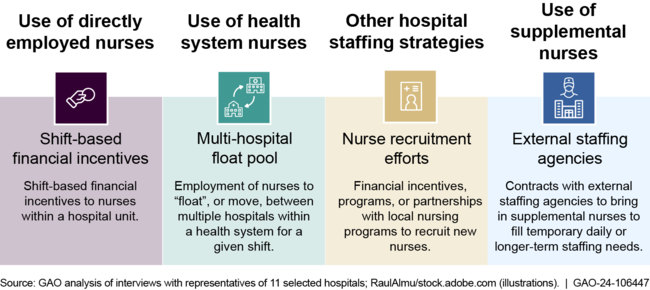Hospitals: Expanded Use of Supplemental Nurses during the COVID-19 Pandemic
Fast Facts
Hospitals rely on nurses, among other staff, to meet patient care needs. When they don't have enough employed nurses to provide care for their patients, they may contract with external staffing agencies for travel nurses or supplemental nurses.
We reviewed data from 6 hospitals and found that use of supplemental nurses increased during the COVID-19 pandemic. For most of these hospitals, the use of supplemental nurses more than doubled.
The average hourly cost of registered nurses increased during this period, with a greater rate of increase for supplemental nurses. We also found similar trends in data from a larger set of hospitals.

Highlights
What GAO Found
Use of supplemental nurses—nurses temporarily contracted by hospitals through external staffing agencies—increased in the selected hospitals in GAO's review during the COVID-19 pandemic. Specifically, GAO requested data from 11 selected hospitals from 2019 to 2022. Of the six selected hospitals that were able to provide complete data for these 4 years, five of the hospitals reported that the proportion of registered nurse (RN) hours worked by supplemental RNs more than doubled. Overall use ranged from 2 to 28 percent in 2022 (see table).
Proportion of Supplemental Registered Nurse (RN) Use in Selected Hospitals, 2019 and 2022
|
|
Hospital A |
Hospital B |
Hospital C |
Hospital D |
Hospital E |
Hospital F |
|---|---|---|---|---|---|---|
|
2019 |
3% |
<1% |
<1% |
4% |
13% |
8% |
|
2022 |
6% |
7% |
16% |
12% |
2% |
28% |
Source: GAO analysis of data on supplemental RN hours or full-time equivalent employees provided by selected hospitals. | GAO-24-106447
Data provided to GAO by the six selected hospitals also show the average hourly cost of RNs increased from 2019 to 2022, with a greater rate of increase for supplemental RNs than for directly employed nurses. Specifically, the percentage increases for these six hospitals ranged from 14 to 45 percent for directly employed RNs and from 53 to 266 percent for supplemental RNs. GAO found similar trends in use and average hourly cost in California hospital data.
Representatives GAO interviewed from 11 selected hospitals reported implementing a range of new and pre-existing strategies, to respond to staffing challenges in the COVID-19 pandemic (see figure). Nine of the 11 hospitals avoided reductions in operating capacity during the pandemic, representatives told GAO. However, representatives from two of the hospitals reported operational changes, such as closing a unit or reducing the number of beds available for patients. Representatives from seven of the nine hospitals credited their hospitals' ability to maintain capacity, as the pandemic continued, to the increased use of supplemental nurses.
Examples of Selected Hospitals' Strategies for Responding to Staffing Shortages

Why GAO Did This Study
Hospitals are reliant on nurses, among other clinicians and staff, to meet the treatment and care needs of their patients. When they do not have enough employed staff to provide care for their patients, they may contract with external staffing agencies for supplemental nurses.
The CARES Act includes a provision for GAO to report on its ongoing COVID-19 monitoring and oversight efforts. GAO was also asked to review hospitals' use of supplemental nurses during the COVID-19 pandemic. This report describes (1) selected hospitals' use of supplemental nurses from 2019 through 2022 and (2) selected hospitals' other strategies for responding to staffing challenges during the pandemic.
GAO interviewed a nongeneralizable sample of 11 acute care hospitals that represent a variety of locations, health system affiliations, ownership types, and numbers of licensed beds. Six of these hospitals were able to provide GAO complete data for 2019 through 2022 on their use of, spending on, and average hourly cost of supplemental nursing staff. GAO also interviewed representatives from four health care staffing agencies selected based on market size and seven academic researchers with relevant expertise. GAO also analyzed 2019-2022 data from California hospitals on the use and cost of nursing staff. GAO selected California as it had publicly available data for directly employed and supplemental nursing staff. GAO also analyzed data from national sample surveys of RNs by the Health Resources and Services Administration in 2018 and 2022.
For more information, contact Leslie V. Gordon at (202) 512-7114 or GordonLV@gao.gov.
